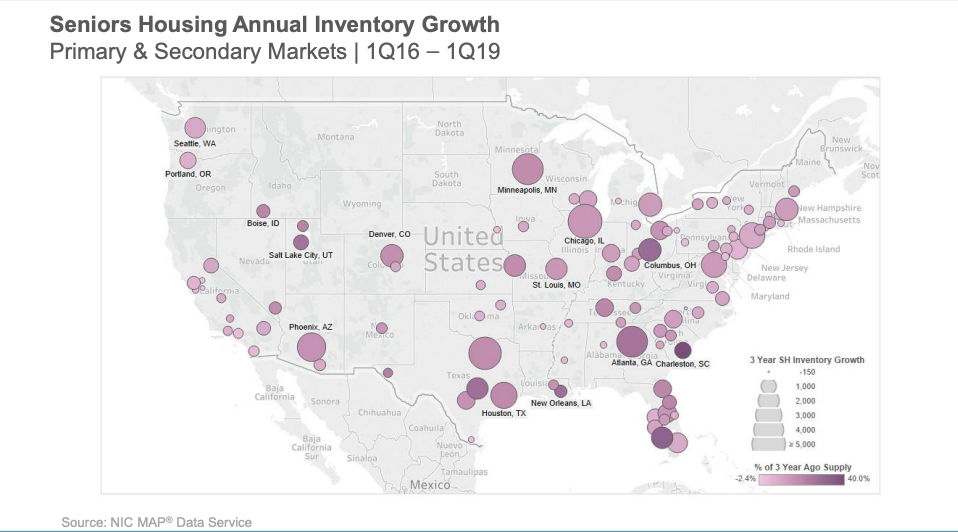A handful of primary and secondary U.S. markets continue to experience elevated senior housing construction, at a time in the ongoing building cycle where absorption is catching up to inventory nationally.
This was one of the top takeaways from a webinar Thursday hosted by National Real Estate Investor (NREI) featuring National Investment Center for Seniors Housing & Care (NIC) Chief Economist and Director of Outreach Beth Burnham Mace and Chief of Research & Analytics Chuck Harry.
Although the webinar mostly recapped the findings from NIC’s Q1 2019 market fundamentals report, as well as the results of the group’s April study on the need for middle-market senior housing, it may prove beneficial for new investors to the senior living space on what markets to target and the fundamentals driving growth in those areas.
Atlanta is booming
Construction starts totaled 4,003 units in the first quarter of 2019, with demand slightly outpacing inventory growth, according to preliminary data analyzed by NIC. But primary markets such as Atlanta, Denver and Houston continue to see high numbers of senior housing construction as a percentage of inventory.
 Courtesy of National Investment Center for Seniors Housing & Care (NIC)
Courtesy of National Investment Center for Seniors Housing & Care (NIC)These cities, along with Phoenix; San Antonio; Riverside, California; and Sacramento, California are high growth markets — areas with booming economies and positive population growth trends better positioned for absorption, Harry said.
Atlanta, in particular, had 15.1% of its inventory under construction in Q1, the most among the 31 primary markets tracked by NIC. The extended construction growth has not impacted occupancy. Atlanta’s occupancy was just above 85% in the first quarter, compared to 84.1% a year ago.
Atlanta’s construction boom has been consistent since the first quarter of 2015, with construction as a percentage of inventory regularly in the double digits. Harry believes this is because Atlanta benefits from low construction and land costs, as well as a favorable regulatory environment.
That confluence of factors has also made Atlanta one of the leading markets for inventory growth the past three years. Demand for senior housing is trickling down to secondary markets, as well.
 Courtesy of National Investment Center for Seniors Housing & Care (NIC)
Courtesy of National Investment Center for Seniors Housing & Care (NIC)Over the past three years, secondary markets such as Salt Lake City, Utah; Charleston, South Carolina; Columbus, Ohio; and New Orleans are seeing inventory increases reaching 40%, outpacing major markets such as Chicago, New York and Minneapolis.
As new investors enter the space and become knowledgeable on market fundamentals, they will have ample opportunities to chase yield in these secondary markets, if pricing keeps them out of the major markets. Still, as occupancy has fallen sharply over the past several years due to supply pressure in some locales, caution and due diligence are musts.
“Individual markets respond to local market conditions as well as local attitudes towards development,” Burnham Mace said. “Investors need to understand local market conditions, supply-demand dynamics and growth drivers.”
Companies featured in this article:
National Investment Center for Seniors Housing & Care, National Real Estate Investor

